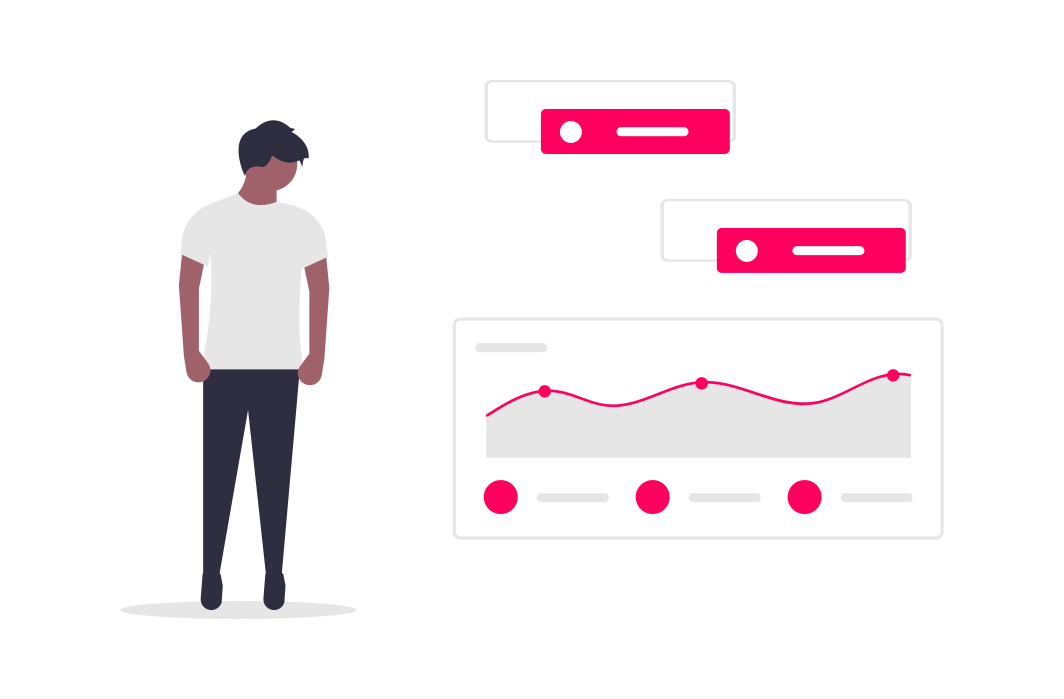The shift from academic writing, such as essays and articles, to complex business reports, can be scary!
A business report is needed in almost any field of work. These are fact-based documents that are used to make decisions in a business.
You can use business reports for several purposes such as pitching an idea, analyzing an idea, pitching a merger, analyzing a merger, proving that your company complies with legal and social guidelines or any specific topic related to your job and work.
So if you have a job, it is crucial that you understand the concept of business reports and how to write them effectively.
In this article, we will talk about the different types of reports and their purpose, the importance of business reports, and how to structure your own in an impactful way!
But hey, first thing first. Let’s understand the concept of business reports a little better.
What is a Business Report? (Definition)
A Business report is defined as an official document that contains factual information, statistical data, research findings, or any other form of information relevant to the course of the job.
This report is a formal document written to-the-point to convey information in a concise yet clear manner. Business reports are majorly used for internal communication within an organization.

Objectivity is a major element while writing business reports. Whatever you say should be supported by data and facts, not opinion and perspective. For example, instead of saying ‘ sales in the last quarter were very low’, you show it by means of data.
The report can vary from one page to several pages depending on the purpose and type of report, which brings us to the second part: Types of Business reports.
Types Of Business Reports
There are many types of business reports used in an organization for various purposes. Obviously, you cant use the same report to analyze employee performance and sales in the last quarter, right?
Here are some common types of business reports:
1. Informational reports
You use this report when your boss asks for data that is purely objective i.e., just plain facts without any reasoning or potential outcomes. For instance, a workforce report stating the number of employees in the company, their duties, department of work, and responsibilities.
Read more: How to Write Project Reports that ‘Wow’ Your Clients? (Template Included)
2. Analytical Report
As the name suggests, this report is used when some critical company data has to be analyzed in order to make informed decisions.
 For instance, analyzing the sales drop in the last financial year. This report consists of sales numbers, a comparison of those numbers with earlier years, and finding reasons for the fall. The report will also indicate possible measures the company can take to solve this problem.
For instance, analyzing the sales drop in the last financial year. This report consists of sales numbers, a comparison of those numbers with earlier years, and finding reasons for the fall. The report will also indicate possible measures the company can take to solve this problem.
3. Research Report
You use a research report when something big is coming up! It could be a potential merger, or a new product line, or a shift in the current way of working.
A big change requires a comprehensive report studying all its implications. For example, if the company wants to introduce a new product, the research report will consist of elements like target audience, marketing communication strategy, advertising campaigns, etc.
4. Explanatory Report
You use this report when you want to explain your individual project to the entire team. Let’s suppose you performed research.
 An explanatory report will showcase the facts, list the findings, and determine the conclusion of the research. It should be written in very simple, concise, and clear words. Although the readers are mostly peers of the same industry, jargon should be avoided.
An explanatory report will showcase the facts, list the findings, and determine the conclusion of the research. It should be written in very simple, concise, and clear words. Although the readers are mostly peers of the same industry, jargon should be avoided.
5. Progress Report
This is a small report used to notify updates in a company.
How was the previous week?
How is the sale for this quarter coming along?
What is the percentage change in conversions since the last week/month?
Questions like these are answered in a progress report. It does not contain analytics. Only information and changes.
Progress reports are a good medium for companies to track their day-to-day work and come up with new ideas for growth and expansion.
Still not convinced? Here are 4 compelling reasons why business reports are important for efficient workflow in an organization.
Read more: What is a Progress Report and How to Write One?
Importance of Business Reports
1. Mode Of Communication
You know how you text or call in daily life to communicate? In businesses, reports are prepared for it. We can say that business reports act as a medium of communication in an organization.
But why is it done?
Well, in big companies, there is an entire line of workflow that takes place. It is also known as a delegation of duties. In this workflow, there are branches, sub-branches, departments, and niche specific zones. If communication is done verbally, information may get lost or contaminated.
So for every important piece of communication, a written report is created. Anyone who needs access to that information can read the report and equip themselves with first-hand data.
2. Decision making
Thinking about launching a new product line? Prepare a report.
Aiming to cut company costs? Prepare a report.
From deciding the target audience to laying off employees, every decision is taken on the basis of detailed reports prepared with facts and stats.
Reports are transferred two-way in an organization. Employees create business reports and send them to higher management for decision making. Upper management creates reports to circulate information, tasks, etc. among the workforce.
3. Crisis management
In case of a crisis, chaos, and panic outbreaks, everyone has an opinion on the matter, and the transfer of thoughts verbally gives rise to workplace gossip.
In such a situation, business reports are created to get everyone on the same page and then factually analyze the problem.
Crisis management reports comprise of the cause of the issue, steps to take for damage control, and policies suggesting future protection from such crisis.
4. Effective management
The delegation of duties is done via reports. Every employee has their own to-do tasks with an assigned deadline. This helps in more sound and effective management of the company.
All the information is in viable written documents, decisions are taken upon careful analysis, and the overall functioning of the company is better using business reports.
So now that we know that we HAVE TO prepare business reports to survive in the corporate world, let’s move on to the next and probably the most important section where we teach you how you can get started on writing a proper report.
Read more: Business Requirements Document (BRD): What, Why, and How to Write?
How to write a business report? (Steps and Format)
Follow this step-by-step guide to create your powerful business report:
Step 1: Create a plan of action
You are writing a business report, not a school essay. You can’t base your report on thoughts as and when they come. Before starting the report, identify its purpose.
Define what you aim to achieve with the report and how you plan to present it. Do not beat around the bush! This will help you write a clear and concise report.
Step 2: Check for an in-house format
Your company may have a specific format for writing reports. Ask your supervisor or check the company’s handbook to find it. Do not blindly trust the internet.
However, if no such format is specified, you can use the standard global format listed in the following steps.
Step 3: Add a title
The title of the report may be specified in the brief you received from your supervisor. If not, you may write your own title. It should be clear, crisp, and be able to convey the purpose of the report.
You should avoid using very long and complicated titles. For instance, use ‘Sales report for FY 2020-21’ instead of ‘Analysing the customer interaction with the company in the last 12 months in comparison to previous years’. People will yawn and leave the room at the start of your report!
Also, add your name and the names of other people involved in making the report. Portraying someone else’s background hard work as your own is highly unethical in the workplace.
Step 4: Write a table of contents
You should include a table of contents page only if the report is long and contains sub-sections.
If this page is added, make sure to write contents exactly in the manner headings are written inside the report. All the contents should be properly numbered for the reader to easily navigate through the report or jump on a specific section.
Step 5: Add a Summary/ Abstract
This is a very important page in any report. You should write the abstract in such a manner that even if a person does not read the entire report, this page can give them a clear and detailed idea of the entire thing.
It should contain your title, issue, key findings, and conclusions. You should basically summarise everything you wrote in the report to fit in the abstract.
Step 6: Write an introduction
Now begins your actual report. On this page, specify the purpose of writing the report along with a brief idea of the main argument.
You can also include some background of the topic on this page.
Step 7: State your methodology
On this page, tell the readers how you created this report. It includes the sources of information, type of data (qualitative or quantitative), channels of receiving information, etc.
This is to equip your readers with the process you went through or, as we can say in the urban slang, the BTS of the report. It makes your report more credible.
Step 8: Present your findings
This is the main section where you present your findings. It should convey that you have done thorough research. So include stats, facts, and graphs to portray the information.

To prevent it from getting messy, align the data into various headings and subheadings. Use pointers, bulleted, or numbered whenever required.
Step 9: Give a conclusion or recommendation
End your report with a compelling conclusion. This should be drawn from previously stated findings.
You can also give recommendations for change or improvement in a policy, supported by valid documentation. The conclusion should come off strong, based on factual data, not biased views or opinions.
Step 10: Add bibliography and references
Adding this section is a legal compulsion in any report wherein the data is taken or inspired from previously published sources.
Let us explain it simply. If you have added any data or statistics in your report, you must give due credit to the original author. Else, it counts as plagiarism, which is a punishable offense.
Also, note the difference between references and bibliography, and don’t confuse the two!
Here’s an example:
Suppose you read a business report online and got inspired by it. Although, you didn’t use any of its data in your own report. In this scenario, you will list that report under the bibliography section.
However, if you took data from that report to directly include in yours, you will list that in the reference section.
Step 11: Proofread
Proofreading or revising is very important before finalizing a report. In this section, check for any spelling errors, grammatical mistakes, or punctuations. These are small mishaps that can make a very bad impression.
Also, while proofreading, check the citations, footnotes, appendices, etc, according to the company standards. There may be guidelines you missed while writing the report!
Bit.ai: The Ultimate Tool For Writing Business Reports
With its new-age cloud technology bit gives your business report superpowers!
You can choose from pre-designed templates and just worry about putting your content into it.
With Bit’s smart integration, you can add rich media elements like cloud files, charts, pdfs, embeds, diagrams, graphs, and much more into your business reports within seconds.

Not only this, bit.ai lets you work with your team in real-time. You can co-edit and use inline comments to bring your colleagues to the same place to make decisions related to your business reports.
You even have document tracking to see who is opening your report and how much time they spent on it.

Few more business templates you might be interested in:
- SWOT Analysis Template
- Business Proposal Template
- Business Plan Template
- Competitor Research Template\
- Project Proposal Template
- Company Fact Sheet
- Executive Summary Template
- Operational Plan Template
- Pitch Deck Template
Wrap Up
As we have seen, writing a business report involves a lot of aspects. All of the time and energy is consumed in writing engaging content, and one tends to forget about the design element.
Yes, the design is a very important aspect of any report. When your report is visually appealing, it engages the reader and stands out in a room full of black and white text.
…and bit helps you do just that!
On bit, you can edit the document according to the type of report you created without compromising on the design. Play around with hundreds of fonts, themes, and color palettes with Bit to create an impact on your work!
Which was your last business report that really brought about a change? Which tool did you use to make it?
Tweet us @bit_docs and let us know!
Further reads:
7 Types of Reports Your Business Certainly Needs!
Performance Report: What is it & How to Create it? (Steps Included)
Formal Reports: What are they & How to Create them!
Business Documents: Definition, Types, Benefits & Steps to Create Them
Technical Report: Definition, Importance, and How to Write it?
16 Best Business Tools Every Business Needs in 2021
How to Write a Business Case: Step By Step Guide

Related posts
Bit.ai | Watch to Learn More
What is Bit.ai?
Bit.ai is an innovative AI-driven knowledge and Document Managment suite designed to empower knowledge workers by streamlining the creation of, documents, wikis, and notes. With an intuitive interface and seamless integration, Bit.ai acts as a versatile assistant to help you collaborate, generate, organize, and visualize your ideas effortlessly. Whether you are drafting a report, managing a project, collaborating with your team or clients, or brainstorming new concepts, Bit.ai brings intelligence and creativity to every aspect of your work process.



